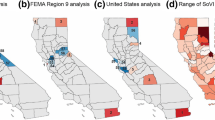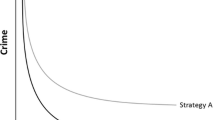Abstract
We compared 2000 county population estimates for Illinois against 2000 census counts. Administrative records (ADREC) and ratio correlation (Ratio-CORR) methods were used to produce two sets of controlled county estimates for 2000; a third set represented an average of the estimates reached using these methods. Another set using the ADREC method was not controlled to any estimate. Also, the 2000 estimates were adjusted for undercount in the 1990 census. We compared performance of these methods with the performance of two naive models: (i) do nothing and (ii) constant growth rate. ADREC estimates were more accurate than estimates from the Ratio-CORR or Average method in terms of Mean Absolute Percent (MAPE) or weighted MAPE. Undercount adjustment in general improved the accuracy of the estimates for all three methods. A top-down or bottom-up approach worked equally well. As a single method, ADREC performed best.
Similar content being viewed by others
References
Ahlburg, D. (1999), Using economic information and combining to improve forecast accuracy in demography. University of Minnesota, Industrial Relations Center.
Ahlburg A. Dennis (1992) ArticleTitleA commentary on error measures International Journal of Forecasting 8 99–111 Occurrence Handle10.1016/0169-2070(92)90010-7
M.J. Anderson S.E. Fienburg (1999) Who counts? The politics of census taking in contemporary America Russell Sage Foundation New York
J.S. Armstrong (1985) Long-range forecasting: From crystal ball to computer John Wiley & Sons New York
Baker, J. (2001), A comparison of postcensal county estimates with Census 2000. Presented at the 2001 FSCPE Fall Meeting, Kansas City, Missouri, September 10–11.
Byerly, E. (1990), Estimates of the population of states:1970 to 1983, pp. 4–7 in Current Population Reports, Series P-25, No. 957.
Davis, S.T. (1993), Evaluation of postcensal county estimates for the 1980s. Paper presented at the Annual Meeting of the American Statistical Association, August, 1993, San Francisco, California.
Hogan, H. (1992), The 1990 post-enumeration survey: operations and results, in Proceedings of the Survey Research Methods Section, American Statistical Association.
E. Kitagawa (Eds) (1980) Estimating population and income of small areas National Academy Press Washington, D.C.
Hoque, M.N. & Murdock, S.H. (1999), Evaluation of Texas population and estimates and projections programs population estimates for 1990. Presented at the Population Estimates Methods Conference, Population Division, U.S. Census Bureau, Suitland, Maryland, June 8.
A. Lee (1989) Estimating total population: an assessment and comparison of methods N.W. Rives W.J. Serow A.S. Lee H.F. Goldsmith (Eds) Small area analysis: estimating total population U.S. Department of Health and Human Services Rockville, MD
Long, J.F. (1993), An overview of population estimation methods, pp. 20-1 to 20-25 in D.J. Bogue, E.E. Arriaga & D.L. Anderton (eds.), Readings in population research methodology, Volume 5. New York: United Nations Population Funds and Social Development Center.
S. Makridakis S.C. Wheelright (1982) The handbook of forecasting: A manager’s guide Wiley-Interscience Publication New York
Martindale, M. (1999), Overview of California’s county population estimating methods. Paper presented at the Population Estimates Methods Conference, Population Division, U.S. Census Bureau, Suitland, Maryland, June 1999.
N.K. Namboodiri (1972) ArticleTitleOn the ratio correlation and related methods of subnational population estimation Demography 9 IssueID3 443–453 Occurrence Handle1:STN:280:CSuC2crkvVA%3D Occurrence Handle4670334
D.E. Pursell (1970) ArticleTitleImproving population estimates with the use of dummy variables Demography 7 IssueID1 87–91 Occurrence Handle1:STN:280:CS2D1MfmtlU%3D Occurrence Handle5524621
J.G. Robinson K.K. West A. Adlakha (2002) ArticleTitleCoverage of the population in census 2000: Results from demographic analysis Population Research and Policy Review 21 19–38 Occurrence Handle10.1023/A:1016537822148
J.G. Robinson B. Ahmed P.D. Gupta K.A. Woodrow (1993) ArticleTitleEstimation of population coverage in the 1990 United States census based on demographic analysis Journal of American Statistical Association 88 IssueID423 1061–1079
H. Rosenberg (1968) ArticleTitleImproving current population estimates through stratification Land Economics 44 331–338
W. Sanderson (1999) Knowledge can improve forecasts: a review of selected socioeconomic population projection models W. Lutz J. Vaupel D. Ahlburg (Eds) Frontiers of population forecasting The Population Council New York 88–117
M. Shahidullah (2003) ArticleTitleUses, methods, input data, and evaluation of population estimates: results from a state survey Applied Demography 16 IssueID2 5–7
M. Shahidullah (1994) An evaluation of the accuracy of 1990 population estimates by age, sex and race for Florida and its counties K.V. Rao J.W. Wicks (Eds) Studies in applied demography: Proceedings of the international conference on applied demography Bowling Green State University Bowling Green, KY 109–119
H.S. Shryock J.S. Siegel (1976) The methods and materials of demography Academic Press New York
R. Smith A. Crosetti (1951) ArticleTitleAccuracy of the ratio method for forecasting city population Land Economics 27 346–348
S.K. Smith (1987) ArticleTitleTests of forecast accuracy and bias for county population projections Journal of the American Statistical Association 82 IssueID400 991–1012 Occurrence Handle1:STN:280:DC%2BD38rls1yqtw%3D%3D Occurrence Handle12155376
S.K. Smith S. Cody (1994) ArticleTitleEvaluating the housing unit method: A case study of 1990 population estimates in Florida Journal of the American Planning Association 60 209–221
S.K. Smith J.M. Nogle (1997) ArticleTitleAn experimental methodology for estimating Hispanic residents Journal of Economic and Social Measurement 231 263–275
S. Smith M. Mandell (1984) ArticleTitleA comparison of population estimates methods: Housing unit versus component II, ratio correlation, and administrative records Journal of the American Statistical Association 79 IssueID386 282–289 Occurrence Handle1:STN:280:DC%2BD38rktFKgug%3D%3D Occurrence Handle12340389
S.K. Smith J. Nogle S. Cody (2002) ArticleTitleA regression approach to estimating the average number of persons per household Demography 39 IssueID4 697–712 Occurrence Handle12471850
Smith K. Stanley M. Shahidullah (1995) ArticleTitleAn evaluation of projection errors for census tracts Journal of the American Statistical Association 90 IssueID429 64–71 Occurrence Handle1:STN:280:DC%2BD38rls12itQ%3D%3D Occurrence Handle12155398
S.K. Smith J. Tayman D.A. Swanson (2001) State and local population projections: Methodology and analysis Kluwer Academic/Plenum Publishers New York
D.A. Swanson J. Taymann C.F. Barr (2000) ArticleTitleA note on the measurement of accuracy for subnational demographic estimates Demography 37 IssueID2 193–201 Occurrence Handle1:STN:280:DC%2BD3cvitVektA%3D%3D Occurrence Handle10836177
U.S. Census Bureau. (March 2003). Decision on intercensal population estimates. Available from <http://www.census.gov/Press-Release/www/2003/cb03cs02.html>.
U.S. Census Bureau. (2001), Data and analysis to inform the ESCAP report, in H.H. Hogan (ed.), DSSD Census 2000 Procedures and Operations Memorandum Series B-1, March 1.
U.S. Bureau Census Bureau (1998), Methodology for experimental county population estimates for the 1980s. Current Population Report Series. P-23, No. 158. Washington, D.C.:U.S. Bureau of the Census.
Author information
Authors and Affiliations
Corresponding author
Rights and permissions
About this article
Cite this article
Shahidullah, M., Flotow, M. Criteria for selecting a suitable method for producing post-2000 county population estimates: A case study of population estimates in Illinois. Popul Res Policy Rev 24, 215–229 (2005). https://doi.org/10.1007/s11113-004-5313-x
Issue Date:
DOI: https://doi.org/10.1007/s11113-004-5313-x




